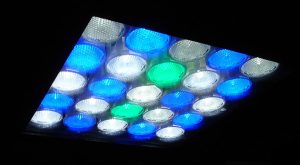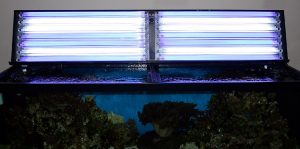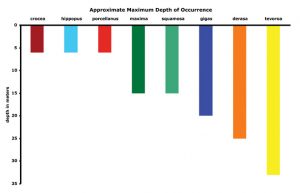As best as I can tell, for as long as tridacnids have been put in aquariums there has been much debate about how much light is needed to keep them healthy. I’ve heard all sorts of ideas here and there, and have even seen specific PAR values recommended for each species. However, most of what I’ve heard is bad advice, which is a result of the general lack of understanding of tridacnid biology. So, I’ll try to straighten things out this month, and save the lives of some clams.
Tridacnids are complicated
To start, one of the biggest problems is the false notion that if various corals can be kept healthy under a given lighting system that tridacnids can be kept healthy under it, too. It’s easy enough to see why many people would think this, but tridacnids are not corals.
Corals are very simple animals, and they don’t really do too much when you think about it. They just sit there and soak up the sun, they don’t move around, and they use very few calories from day to day to stay alive. Tridacnids, on the other hand, are actually very complicated animals with mouths, stomachs, intestines, kidneys, gonads, a beating heart, big gills, etc. They also use millions of tiny cilia to draw water into their bodies non-stop. Yes, they just sit around most of the time, but there’s a heck of a lot more going on inside that shell than you might think. So, it takes a lot more calories to keep one alive.
Both can get some of their calories by eating plankton and such, but the vast majority of their needs are covered via the photosynthesis carried out by their complements of zooxanthellae. So, they both require light, and tridacnids generally need a lot more than corals. Therefore, you should never assume that good coral growth would equate to good clam growth under the same lighting. More on this in a minute, though.
Tridacnid species aren’t all the same
Next, I’ll point out that some tridacnid species can live at greater depths than others, and can survive with less light than others. Tridacna crocea, Hippopus hippopus, and H. porcellanus aren’t found at depths greater than about 20 feet, and I don’t think I’ve ever seen a single T. crocea living deeper than about ten. However, T. maxima and T. squamosa can be found at more than twice this depth, living down to around 50 feet, and T. gigas can be found even deeper, at around 65 feet. Then there’s T. derasa, which can be found all the way down to around 80 feet, and the deepest-living species, T. tevoroa, which can be found down to a about 110 feet (but isn’t offered in the hobby). This could be due to some structural differences between the various species, differences in their metabolism, or they may preferentially carry different strains of zooxanthellae, or all of the above, or something entirely different.
Regardless, intensity at the surface on a bright day in the tropics is around 2,500 µE/m2/s, but at 3 feet below the surface, depending on water clarity, light intensity is already reduced by about 15%, and by 110 feet it has dropped by about 94%. This means intensity drops to about 2,125 at just 3 feet and all the way down to about 150 by 110 feet, and that’s in clear oceanic waters on a clear day. So, the deepest living tridacnid has never been found where intensity is lower than about 150 µE/m2/s, and all the rest live in waters where the intensity is higher.
By comparison, I’ve taken light readings in a couple of relatively dim reef aquariums lit with fluorescent bulbs and found that there are many stony corals that can live and grow under less light than this. Some examples are (in µE/m2/s):
| Coral Species | µE/m2/s |
|---|---|
| Pachyseris rugosa | 110 |
| Montipora capitata | 110 |
| Montipora spongodes | 110 |
| Pocillopora sp. | 107 |
| Montipora sp. | 100 |
| Monitpora digitata | 95 |
| Acropora cervicornis | 80 |
| Montastrea sp. | 80 |
| Acropora millepora | 79 |
| Scolymia sp. | 70 |
| Turbinaria peltata | 64 |
| Turbinaria reniformis | 58 |
| Fungia sp. | 54 |
| Euphyllia cristata | 52 |
| Trachyphyllia geoffroyi | 40 |
| Caulastrea furcata | 32 |
Again, all of these were healthy and growing, so it should be clear that you could have a reef aquarium where the light intensity is less than 150 µE/m2/s and still have lots of growing corals, while not having enough light to keep any species of tridacnid healthy.
Anyway, I can tell you for sure that trying to get a T. crocea to live on the sparse light a T. derasa might receive at 80 feet just isn’t going to work. Likewise, T. derasa can’t live side by side with T. tevoroa at 110 feet. So, how much light is needed depends a lot on which species of tridacnid is being considered.
Individual tridacnids of each species aren’t all the same, either

Here’s a good example of how genetically diverse clams of the same species can be. These three T. croceaclams came from the same parents at the same time and have lived right next to each other since being placed in this outdoor tank. Notice the big one is about twice the size of the small one.
In addition to these species-level differences, there’s also variability between individuals. There are countless subtle genetic differences that can make one clam more fit than another under the same conditions, even if they are the same species. Individuals may be carrying different strains of zooxanthellae, too. So, all of the members of a given species can’t necessarily adapt to the same minimum light intensity, either. Sibling clams can grow at different rates and grow to different sizes, etc. under the same environmental conditions due to genetic differences, and I’m certain that some clams have varying abilities to deal with more or less light, too.
For example, I’ve seen areas where there are hundreds of T. maxima within a few feet of the surface in an area of sloping reef, but their numbers dropped off drastically within the next 20 feet depth, and almost none were living within the last 20 feet of their maximum reported depth. Actually, I’m pretty sure I’ve never come across one any deeper than about 35 feet. The same pattern of distribution is generally seen with the other species, too. Many individuals in shallower, brighter waters, with abundance dropping steeply as the depth approaches their reported maximum depth of occurrence.
Still, the salinity and temperature are essentially the same across these depths, and larval clams are at the mercy of waves and currents for several days, which can scatter them all over the place. This means that while the larvae are spread across a reef and nearby waters, the ones that settle in shallow waters are apparently more likely to survive while those that settle into deeper waters are not. So, it would seem that some individuals, for some reason(s), are better able to tolerate lower illumination than others, and go on to survive where others can’t. They’re the tough ones.
Further discussion and my recommendations

What about LEDs? Well, I’ve seen a lot of new LED fixtures over the last few years, and some of them are bright enough to put your eyes out, while many others aren’t very bright at all. So, I can’t say much about how well they may work with tridacnids. If you want to try, I suggest using an LED fixture with an intensity that’s comparable to a metal halide fixture, and then look for shell growth.
With this in mind, you should be able to see that there’s no way to come up with a single number that would be the exact minimum amount of light that a species of clam can live under, because one clam’s need for light is not necessarily the same as another clam’s, even if they’re the same species. Basically, the idea of asking for a specific lighting number would be like asking how many calories a day a Cocker Spaniel needs to survive without knowing its age, size, metabolic rate, etc.
This is very important to remember, as you will always want to provide at least enough light to keep any clam of a given species alive, not the minimum that you think an individual of the species could possibly live under. Of course, there are literally hundreds of bulbs and possible combinations of bulbs that can be used over reef aquariums, and they can get dimmer with age, as well. So, I obviously won’t be covering every possibility below, but will give some conservative recommendations based on personal experiences and the advice of numerous other experienced aquarists.
To start, I’ll say that all available species of tridacnids can and have been successfully kept under fluorescent lighting systems using high-output bulbs with good reflectors and/or metal halide bulbs. So, it is certainly possible to provide what they need through the use of commonly-offered lighting systems.

By the way, you can’t have too much light, as long as a specimen is given plenty of time to adapt to a possible increase over what it’s used to. All species available can be found in very shallow waters around reefs and have been raised on farms in very shallow outdoor tanks (like these T. crocea) without being over-illuminated, and our lights don’t come close to the brightness of the tropic sun in three feet of water.
Still, in the case of T. crocea, which is apparently the most light-hungry species of the bunch, fluorescent lighting will only suffice in very shallow tanks, or if a specimen is placed very near the water’s surface in a deeper tank. I would highly recommend squeezing as many bulbs into the canopy/fixture as possible at that, and then mount the bulbs so that they are as close to the water as possible, and then place the specimen within a foot of the surface, preferably less. Again, some individuals (the “tough” ones) may be able to get by at times with less light, or further down in deeper tanks, but I implore you to not take chances. So, I have to say that metal halide lighting is really the way to go for this species.
Moving along, H. hippopus and H. porcellanus are the other shallowest-living species, and I say give them as much light as you would give a T. crocea. Again, several high-output fluorescents will probably suffice over small tanks, but metal halide lighting is still preferred, and is required for deeper tanks.
T. maxima can live at over twice the depth that these other three can, and should be able to get by with much less light. So, many individuals can be kept under fluorescent systems, even if they’re on the bottom of shallow to medium size tanks, as long as there are plenty of bulbs in use. But, they’re far more abundant in shallow waters, and much less so at the deeper end of their range, so I still say you should play it safe and go with metal halides, or at least place specimens closer to the bulbs in medium to large size tanks.
T. squamosa can live at about the same depth as T. maxima, but from what I’ve seen, they don’t drop of in numbers with depth to the degree that the other species do. Thus, they seem to be generally better at living under reduced light than T. maxima is, despite the fact that both of these species have the same reported maximum depth of occurrence. This observation has been backed up by my experiences with them in aquariums too, as they’ve categorically been more tolerant of lower light/greater depth in tanks. Thus, I think it’s safe to say that T. squamosa can typically be kept under fluorescent lighting at the bottom of both small and medium size tanks without worry (again, as long as there are several bulbs with reflectors). But, I still say get metal halides for deeper tanks.

Hard to believe that despite the continued coral growth, this 14-bulb T-5 fixture wasn’t bright enough to keep my T. derasa healthy after it had been fine under metal halides for about three years.
T. gigas, on the other hand, is very uncommon near its maximum reported depth, so I’d treat them the same as T. squamosa, even though they have been found many feet deeper. Fluorescents will do in small to medium size tanks, but metal halides should be used for deeper ones. Note that these are giants though, and it’s probably best that you don’t bother trying to keep a T. gigas in a relatively small tank anyway. So, I say keep a T. gigas in a big tank with metal halides, unless you’re absolutely sure that you’ll be getting a bigger tank in the (near) future, or can find your oversized clam a new home somewhere else.
Lastly, there’s T. derasa, the deepest living species we can get. T. derasa tends to be especially hardy and while using several fluorescent bulbs and reflectors over small to medium tanks is all that is needed, this is the one species that I say can often be kept under fluorescent lights even if they are on the bottom of deeper aquariums. Not always though, as I had one in my 125 gallon tank for a few years that immediately stopped growing after I switched from three 175w metal halides and two 165 V.H.O. fluorescents to 14 three-foot T-5 bulbs with reflectors (seven bulbs over each half of the tank). Even after

Shell growth is a good indicator of health. If water quality and disease aren’t issues, there should be some growth if the lights are bright enough. It’s seen as the band, thick or thin, of light material at the shell’s rim.
a few weeks it still didn’t resume its growth, and I had to remove it. So, I still say use metal halides if at all possible, just to be sure.
Speaking of growth, watching for it is the key to figuring out if you really have enough lights. If your water quality is up to par, and a clam is free of disease, it should add on new shell material if it’s getting enough light. So look for new, white material at the rim of the shell. If there’s no growth, then the lights are probably too dim. This is important to remember because tridacnids can take months to slowly starve to death, and everything can look fine right up to that point. If they’re slowly starving, they won’t be doing any growing, though.
To summarize, it is impossible to give a single number recommendation when it comes to tridacnids’ lighting requirements, even for a particular species. Each clam is genetically different, and some members of a given species will need more light than others. There is no way to determine this by looking at them though, so to be safe you need to provide enough light to keep any member of the species alive, and the best way to do this is to use intense metal halide lighting, or a fluorescent lighting system that includes quality reflectors and as many bulbs as will fit over the tank. If you’re not sure if your lights are bright enough, always look for shell growth, and take action if there isn’t any.
And don’t forget, this and many other subjects are covered in great detail in Giant Clams in the Sea and the Aquarium, so grab a copy if you want to do some further reading on the topic.





0 Comments